"If you look at Newark, it’s hard to comprehend how anyone ever thought it acceptable to put a sewage treatment facility, the largest trash incinerator in the state, two power plants and a giant port together in a small area that is next to the longest Superfund site in the country—the Passaic River,” says Maria Lopez-Nuñez, deputy director for organizing and advocacy for Ironbound Community Corp. in Newark, N.J. “At what point do we protect human health?”
Research validates the risks faced by those living closest to pollution-intensive facilities, some sited decades ago in low-income or heavily minority communities—whether for cost, expedience or tied to past racism—that now may also be climate-change danger zones.
Newark residents face the nation’s second-greatest cancer risk due to diesel emissions and 25% of school-age children have asthma, double the state and national average.
Read other Engineering Justice series articles:
Bringing Equity to Infrastructure Inequality
The Roads to Justice: Building New Bridges
A Harvard University study of 3,000 counties last year is the first to link long-term air pollution exposure to COVID-19 death rates, while a new U.S. Environmental Protection Agency report says underserved communities are least able to prepare for, and recover from, heat waves, poor air quality, flooding and other effects, and are particularly vulnerable to severe climate change harm.
For environmental justice (EJ) activists, it’s a way of life. Lopez-Nuñez, a Newark resident grew up in the former manufacturing-heavy Bushwick section of Brooklyn, N.Y., "before gentrification," she says.
The activist adds that “even if you move to a place with green lawns, you still have respiratory issues.” Her mission is clear: “Justice must be baked into the foundation of the future that we need to build and unbuild.”
Read more about the impact of environmental justice on the Line 3 oil pipeline project in Minnesota
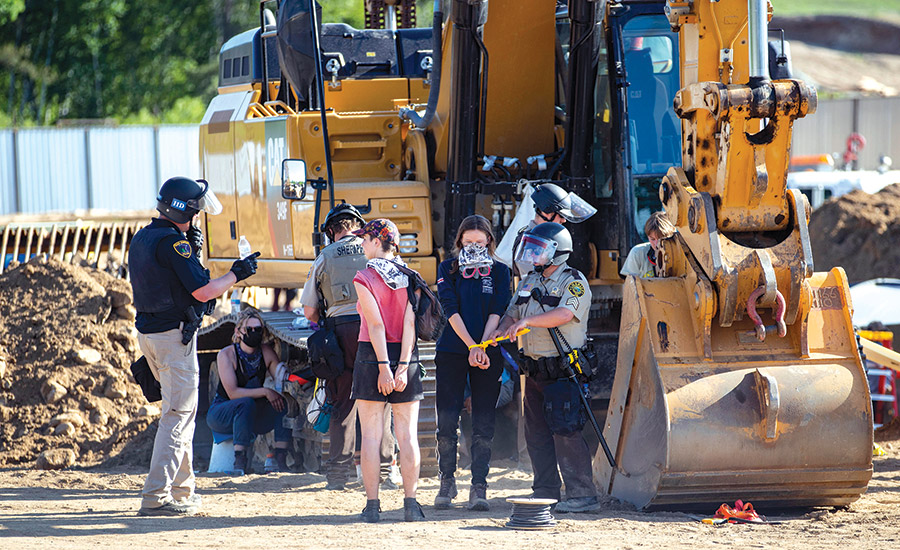
Protests of the Line 3 oil pipeline in Minnesota, including those at worksites (above), claim the now complete pipe replacement project from Alberta to Wisconsin poses risks to water resources; Native American tribes also oppose the project (below), claiming it violates tribal sovereignty and treaties with the U.S.
Photos: Above,Alex Kormann/Star Tribune via AP; Below, Kerem Yucel/AFP via Getty Images
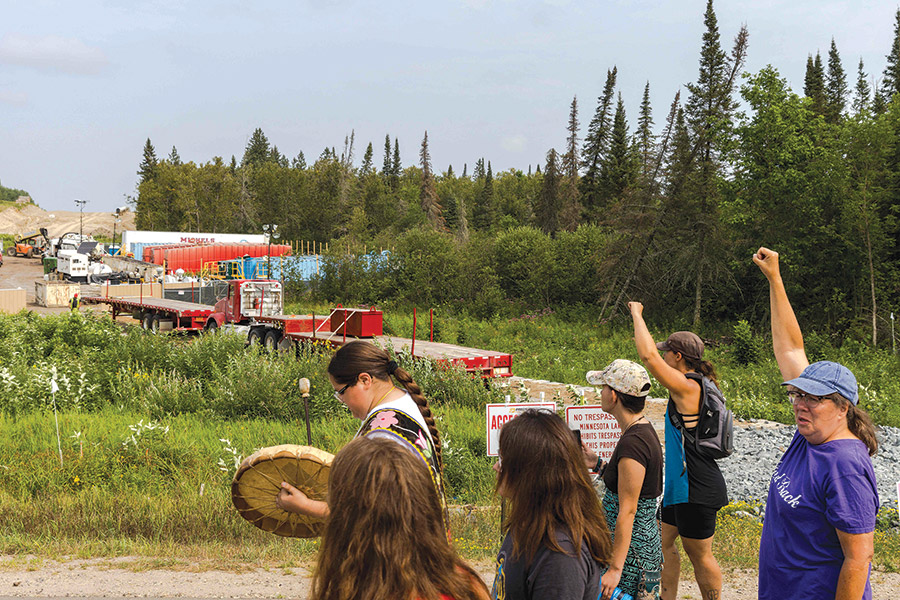
Foundations
The environmental justice movement linked to pollution, bias and health disparities dates back decades, growing from efforts such as those by Robert Bullard, an activist since the 1970s who is often described as the “father” of the movement. Now a professor of urban planning and environmental policy at Texas Southern University, he authored, in 1990, Dumping in Dixie: Race, Class and Environmental Quality, which highlights planning and environmental review lapses and racism in siting industrial and waste disposal projects in southern Black communities.
The seminal EJ report spurred introduction of environmental justice legislation in 1992, sponsored by then-Senator Al Gore and the late Georgia Rep. John Lewis, which would have mandated the U.S. Environmental Protection Agency to track communities with disproportionate pollution burdens, make industrial project permitting more transparent and fund local community efforts.
The bill died in Congress, but President Bill Clinton’s executive order two years later began to address EJ issues, with mixed results since then. President Joe Biden has enacted a more sweeping government-wide push that includes earmarking 40% of federal investment to improve underserved community quality of life under the Justice40 program. New Congressional bills and state actions also are ramping up to expand strategies and address loopholes.
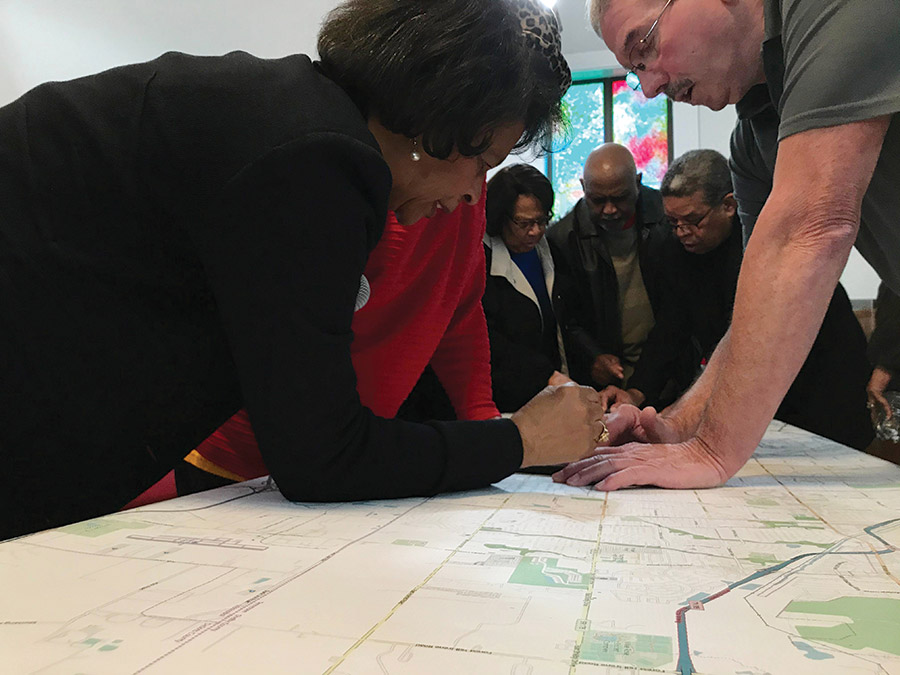
Memphis residents along route of the now canceled Byhalia oil pipeline were concerned about its leak risk to an historic Black-owned neighborhood and a drinking water aquifer.
Photo: Laura Testino-USA Today Network
The issues and impacts are visceral for those who coexist with industrial pollution as communities, governments and business come to terms, not always easily, with how to address and plan for disproportionate effects and greater risks ahead.
Communities “are becoming more vocal and organized in confronting concerns related to new facilities near them, especially regarding greenhouse gas emissions,” says Lytle Troutt, president of consultant Wood plc’s environmental unit. ““Open and transparent communication employed early on increases the likelihood of finding balanced and agreeable solutions during the siting process. Owners are planning for sufficient time in development schedules to account for this process to unfold.”
He and other design firm executives declined to identify projects and owners for which they have consulted on environmental justice issues.
Taylor Lilley, EJ staff attorney at The Chesapeake Bay Foundation, notes a 2017 study it commissioned of Baltimore’s 35-year-old waste-to-energy facility run by Wheelabrator LLC that links it to $55 million in resident health costs and five deaths annually from pollutant particles produced. “Imposition of these facilities often comes as a result of the lack of a meaningful role for community input in decision-making,” she says. “The company did not conduct an environmental justice analysis before building the facility nor did the state require one. That mode of action is no longer acceptable.”
The incinerator was to be closed this year, but it gained a 10-year city extension, with the company and others defending its operation as meeting current rules and saying a shutdown would cost residents $100 million. Maryland and 23 states classified trash burning as renewable energy as of 2018, says one environmental group study, but Baltimore officials will enact a plastic bag ban on Oct. 1 and are weighing new waste recycling strategies.
“We are committed to partnering with communities we serve—and especially any that are vulnerable or overburdened,” says David Biderman, CEO of the Solid Waste Association of North America. “We will work with them ... and others to minimize the impact of our operations while we continue to provide an essential public service.”
Veolia SA, which says it “operates more water, wastewater and waste facilities than anyone in the world” for public and private clients, recommends “fostering adaptations to the climate emergency and its consequences ... by designing out waste and pollution from facilities.”
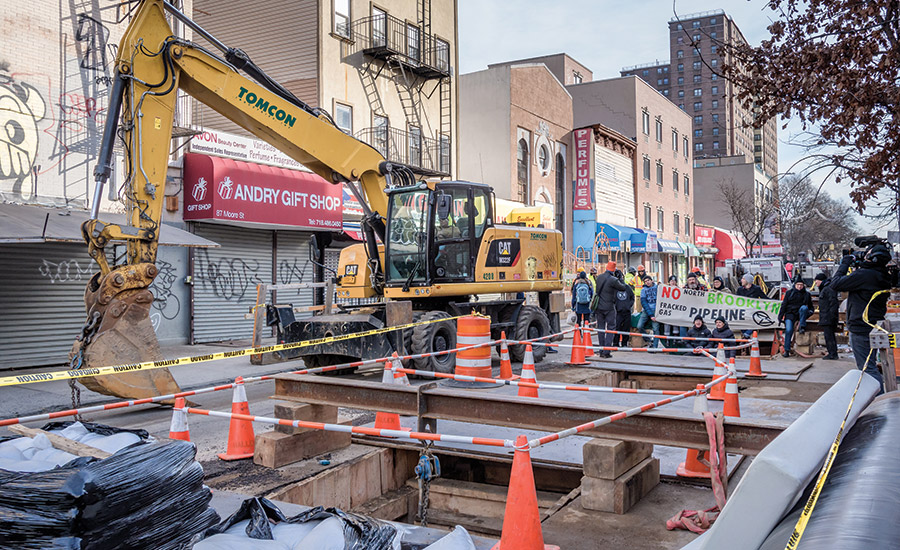
A complaint filed this month to U.S. agencies against a Brooklyn, N.Y., gas pipeline claims it has more impact on already pollution affected Black and Latino communities.
Photo by Erik McGregor/LightRocket via Getty Images
Rising Up
In Louisiana, the impact of Hurricane Ida has revived the justice debate over a 128-MW, $210-million natural gas power plant completed last year by utility Entergy in New Orleans as an emergency supply, despite fierce opposition from its mostly Black and Vietnamese community neighbors. The plant did not operate for two days after the storm hit on Aug. 29, and then supplied power only for a small area.
Courts upheld city approvals of the plant in challenges led by the Deep South Center for Environmental Justice, even as officials fined Entergy $5 million in 2018 for hiring actors as plant supporters at hearings. In a statement, Entergy said full power restoration “will still take time given the significant damage across the region,” with one executive pointing to “a lot of misinformation out there.” A council probe into the power failure could take months, with disputes set to continue between community advocates and officials.
But utilities are boosting attention to impacts in the fast-moving energy transition. “Investors are asking for these to be addressed and for proof. That has caused some to go back to the drawing board, while others realize the current operational footprint near an EJ or sensitive community may not be sustainable,” says Sara Mochrie, vice president and environment market director, energy at design firm WSP USA. “if an existing power generation facility that has been operating adjacent to a neighborhood for 40 years and with recent change in state regulations, its future permits may not be renewed without significant changes in operation to reduce impacts. The concern is that many of the regulatory changes did not come with specific instructions for a path forward, so acquisitions of new approvals don’t come with a playbook and that creates risk and uncertainty.”
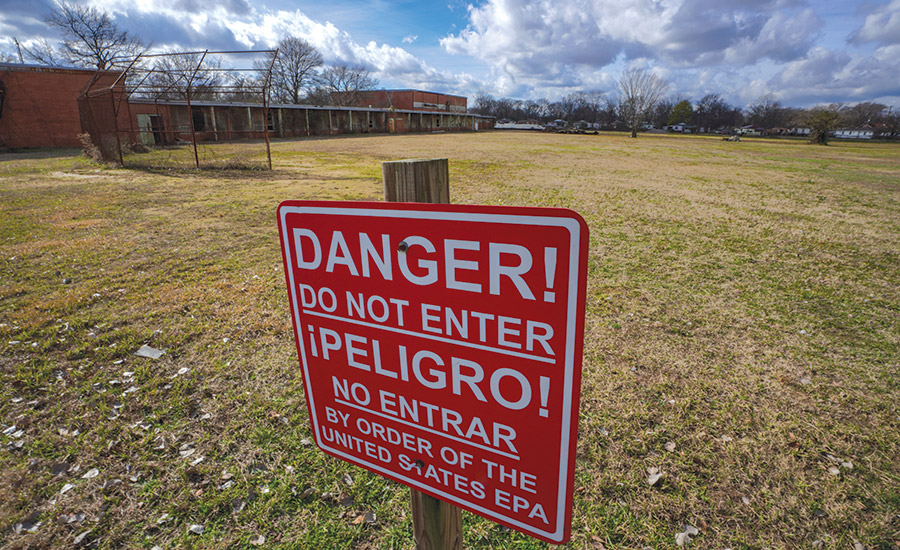
Racist zoning a century ago in Birmingham, Ala., left one Black neighborhood an industrial toxic waste area that became a federal Superfund cleanup site.
Photo by Bonnie Jo Mount/The Washington Post via Getty Images
Washington state’s Clean Energy Transformation Act requires utilities to generate 100% of their power from renewable or zero-carbon resources by 2045, with mandates to distribute “benefits and burdens” to customers during the transition and consider impacts on communities and vulnerable populations, says a state Utilities and Transportation Commission spokesman. Three state utilities, PacifiCorp, Avista and Puget Sound Energy, must form an equity advisory group and file a public participation plan every four years.
Mike Doyle, senior project manager at Power Engineers, says environmental justice community analysis and human heath assessments have been required since 1994 for power projects on federal lands and involving multiple federal agency signoffs. “The community outreach approach is key to hearing about potential challenges where transmission and distribution infrastructure is being planned,” he says.
“Environmental justice isn’t a new issue, but now there is a name for it,” adds Steve Nalefski, a Burns & McDonnell senior vice president. “We are seeing clients take a step back to proactively look at land use and how their projects may affect surrounding underrepresented communities. Our challenge will continue to be how we engage and represent them.”
Legacy of Bias
Land use and zoning decisions made over a century's time left residents in a predominantly Black neighborhood in Birmingham, Ala. living with contamination on their properties that eventually became a federal Superfund site.
But even as recently as August, a nearby industrial company, Bluestone Coke LLC, violated its air permit for at least a year by failing to control air emissions, said an Aug. 25 lawsuit by the Jefferson County Dept. of Health, which denied a new permit. The action followed a 2015 civil rights complaint filed to federal EPA against the department after it denied a permit rehearing. The complaint asks EPA to investigate the disparate impacts of air pollution in the majority Black neighborhoods near the plant. Coke is a component in steel production, a long-time industry in Birmingham.
The city chose to ignore a 1917 U.S. Supreme Court ruling that overturned racial zoning ordinances, such as one that contended that "threats to peace were imminent and severe if African Americans and whites lived in the same neighborhoods,” public health experts at the University of Alabama, Birmingham, wrote in a 2019 article in the International Journal of Environmental Research and Public Health. They called the Birmingham site “a story of environmental injustice,” with the need to maintain order overruling constitutional rights of those involved, despite clear risks posed by heavy industry pollution in the area.
“Local and state governments have played a role in both generating the problem and offering mediocre solutions to communities,” the university researchers said.
EPA determined in 2011 that a time-critical removal of heavily toxic soil was needed, proposing the site for the Superfund site cleanup list in 2014. But state officials fought the action, leaving taxpayers rather than polluting companies to pay for the cleanup.
Lance LeFleur, director of the Alabama Dept. of Environmental Management, said that any other approach “would have delayed progress by decades.” He expects site cleanup to finish in about two years. EPA has cleaned up soil at 533 properties as of February 2021, out of 645 that need remediating. About 71,000 tons of contaminated soil has been excavated so far.
EPA wants to sample more properties for contamination, seeking permission from sometimes skeptical residents who had been pressured by an Alabama lawmaker to oppose testing. He pleaded guilty in a scheme to use his influence to keep the site off the federal cleanup list. “As with so many other environmental justice communities and issues, it’s never just one thing,” says Michael Hansen, executive director of the Greater Birmingham Alliance to Stop Pollution (GASP).
Two years ago, Bluestone bought the plant, which was failing and in disrepair, the firm’s Birmingham attorney Alan Truitt told ENR. It has invested $40 million to address the plant condition, he says. The company appealed the permit denial and operates while in discussions with the county. But GASP wants the 1920-built plant shut down. “No one should have a coke plant in their backyard,” Hansen says.
Birmingham Mayor Randall Woodfin says the level of non-compliance identified in the complaint makes it clear the company should not operate in its location. “It’s taken a long time to see action. It’s slow and frustrating,” Hansen says.
ABC Coke, owned by Drummond Coal Co., also is a “potential responsible party,” says EPA, as are U.S. Pipe and Foundry, Alabama Gas, (now Spire) and KMAC Services, an industrial and construction salvage firm.
There are 32 toxic release-reporting plants in Birmingham, with 1.9 million lb of chemicals released in 2017, the public health experts said. Plants in the North Birmingham area with the largest reported releases include American Cast Iron Pipe Co., ABC Coke and Akzo Nobel Coatings Inc.
“We’re trying to keep pressure on to reduce air pollution from industry in the area,” says Hansen. GASP and others want residents relocated and the site used as a community owned solar farm. Community advocate Malcolm Michael, executive director of the People’s Justice Council, wants the Superfund site expanded to include cleanup of more properties and residents relocated.
Advocates Energized
Justice advocates are energized by the recent defeat of the proposed 45-mile Byhalia oil pipeline in Memphis, which was set to be routed through predominantly Black communities and posed a risk to a key aquifer. It was canceled in July by developers Plains All American Pipeline and Valero Energy despite an eminent domain legal ruling in their favor. Developers cited changing energy market demand and community opposition boosted by politicians and entertainment celebrities.
“I AM DIRECTING [THE CORPS OF ENGINEERS] TO PREPARE AN EIS TO ASSESS THE [FORMOSA PLASTICS] PROJECT’S POTENTIAL IMPACTS ON THE QUALITY OF THE HUMAN ENVIRONMENT IN THE REGION.”
— JAIME PINKHAM, ACTING ASSISTANT U.S. ARMY SECRETARY
Also representing a change in direction is the U.S. Army Corps of Engineers Aug. 18 decision to perform a full environmental impact statement for the massive $9.4-billion petrochemical complex proposed by Formosa Plastics in St. James Parish, La., the heart of the chemical corridor derided by justice advocates as “cancer alley.”
Jaime Pinkham, acting U.S. Army civil works assistant secretary, said in a tweet that the expanded review would “assess the proposed project’s potential impacts on the quality of the human environment in the region and support a final decision to modify, reinstate or revoke” a 2019 permit, which was suspended last fall after a court ruling in an opponents’ lawsuit.
The Corps already acknowledged to a federal judge last year that a less intensive permit review to allow Formosa to fill in wetlands on a 2,300-acre site along the Mississippi River had errors in analysis.
Pinkham, appointed in April, said the new review “will provide opportunities for voices to be heard in an open, transparent and public way.”
His decision was based on “several areas of concern” that include “environmental justice implications,” says an Army spokesman who did not comment on whether the Corps is rethinking other permits and environmental reviews.
“The Army Corps has finally heard our pleas and understands our pain,” said Sharon Lavigne, a parish resident and local activist.
Janile Parks, a spokeswoman for Formosa’s local unit said “major” construction for the project has been on hold since November, but the firm “will continue to work with the Corps as we receive more guidance on the additional evaluation.” She said Formosa has “unwavering commitment to the parish and to Louisiana.”
American Petroleum Institute member companies “strive to implement a high standard of engaging communities and conducting environmental, social and health impact assessments for new projects and existing operations to continuously evaluate and mitigate potential impacts," says Aaron Padilla, director of climate and ESG policy. “They are committed to supporting communities that may be disproportionally impacted and addressing any potential inequitable effects.”
Justice advocates such as Beverly Wright, executive director of the Deep South Center for Environmental Justice and a member of the White House's environmental justice advisory council, seek a "holistic response" that includes investments in job training and workforce development. In a July opinion, she notes that her group runs training programs for young people from affected communities to earn certifications in lead abatement, asbestos removal, mold remediation, hazardous waste operations and emergency response, with 85% gaining jobs. "The Biden administration could take this effort to scale, launching similar programs in hard-hit communities across the country," she says.
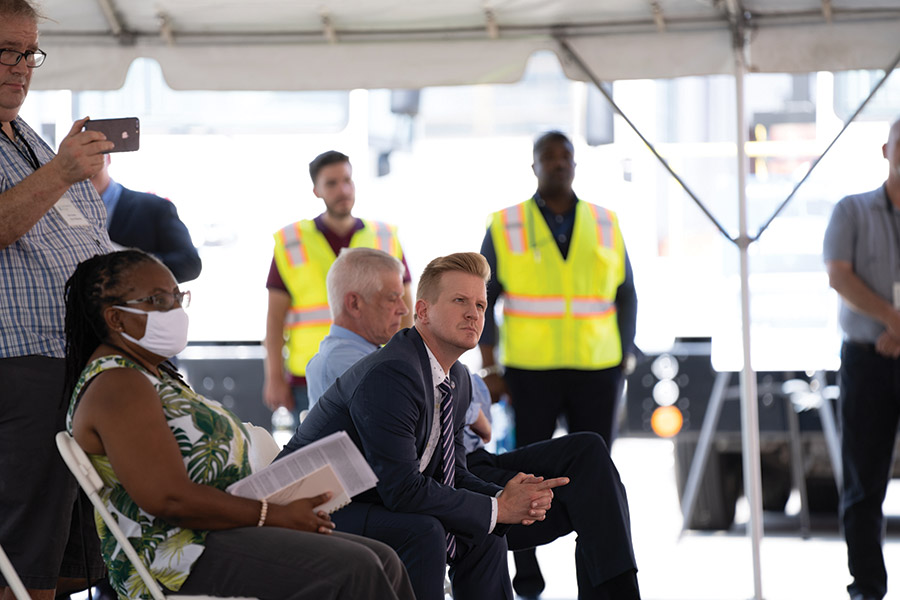
New Jersey Dept. of Environmental Protection Commissioner Shawn LaTourette (above, seated right) and justice advocate Kim Gaddy (seated left) watch deployment of new zero-emission equipment at a Newark port terminal. Waste firm Covanta says state residents can see pollution emission levels online in real time.at its three N.J. incinerators, including in Camden, (below)
Photos: (Top) New Jersey Dept. of Environmental Protection; (Bottom) Covanta Holding Corp.
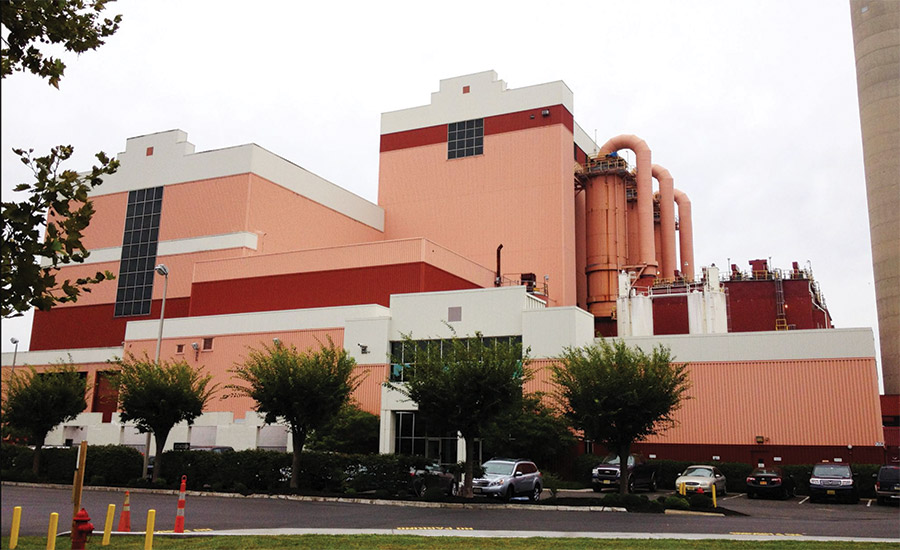
Opaque
Five opponent groups in Brooklyn, meanwhile, filed a federal complaint to EPA Aug. 30 against utility National Grid and two state environmental agencies, claiming they violated state and federal civil rights laws by building and operating a seven-mile fracked gas pipeline through predominantly Black and Latino communities already burdened by health disparities, with no other options analyzed.
“National Grid evaded public hearings and disguised the nature of its construction work so that community members did not learn of the pipeline until it was complete,” the complaint argues. National Grid did not comment on the Brooklyn action but said all utilities are participating in a Public Service Commission review to “update the gas planning process ... including the importance of stakeholder engagement.”
EPA must decide by month’s end whether it has jurisdiction to accept the complaint for investigation, a spokesman says.
“OUR MEMBERS STRIVE TO IMPLEMENT A HIGH STANDARD OF ENGAGING COMMUNITIES AND CONDUCTING ENVIRONMENTAL, SOCIAL AND HEALTH IMPACT ASSESSMENTS FOR NEW PROJECTS, AND ARE COMMITTED TO SUPPORTING [THOSE] THAT MAY BE DISPROPORTIONALLY IMPACTED.” —
—AARON PADILLA, AMERICAN PETROLEUM INSTITUTE
From Low Profile to Spotlight
Environmental justice issues decided in an Aug. 3 federal court of appeals ruling for two Texas projects are pushing one formerly low-profile federal agency into the spotlight.
The Federal Energy Regulatory Commission (FERC), which approves construction of interstate pipelines and other energy infrastructure, must reconsider the effect of two new Texas liquefied natural gas plants and two 135-mile pipelines on minority communities and on climate change, the court said.
The ruling supports the view of Richard Glick, a FERC board member elevated to chairman on Jan. 21, that the agency should more aggressively make sure its approvals “don’t unfairly impact historically marginalized communities.” He said failure to do so puts FERC decisions, and industry investments made based on them, in legal peril.
The court reviewed FERC’s 2019 approval of two LNG export terminals proposed for the majority Latino community in Cameron County, Texas—the Rio Grande LNG plant with associated pipelines and Texas LNG plant—both of which opponents said would put low-income residents in nearby neighborhoods at disproportionate risk from dangerous air pollution.
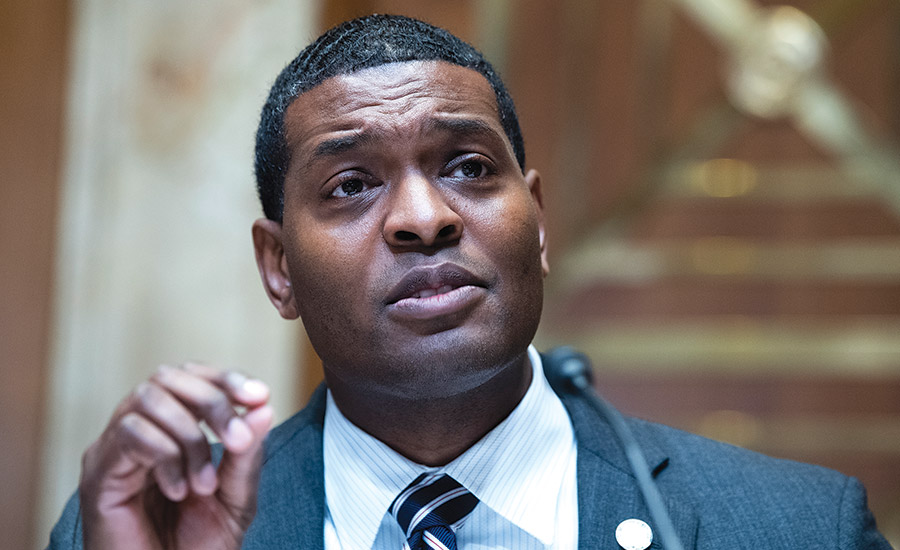
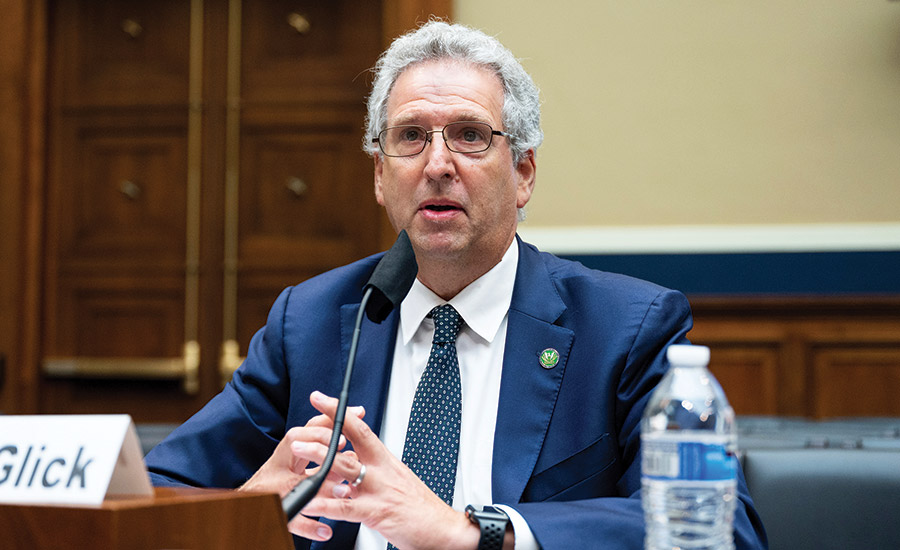
U.S. Environmental Protection Agency chief Michael Regan (top) and Federal Energy Regulatory Commission Chairman Richard Glick (above) are executing new environmental justice agendas for their key agencies under the Biden Administration's sweeping program
Photos: (Left) by Tom Williams/CQ Roll Call via AP Images; (Right) by Michael Brochstein/SIPA USA
Dissenting in the original decision, Glick said FERC can’t “turn a blind eye to the incremental impact that increased pollution will have” on communities.
Glick told a House Energy and Commerce subcommittee hearing on July 27 that he became acutely aware of the issues after reading FERC’s environmental review of the LNG plants. It assessed impacts only for communities within a two-mile radius, despite evidence that those located 30 miles away would be affected by emissions, and it did not compare effects to a broader general population group.
As such, Glick told House legislators, the FERC review said “there are only Hispanic people here so there is no environmental justice impact.” Ruling that reasoning as “arbitrary,” the court said FERC must reconsider its analysis. Environmentalists had said in earlier project comments that FERC’s review encouraged developers to site facilities “in the poorest and most disadvantaged locations.”
LNG developers are hopeful the projects eventually will be approved, since the court said it is “reasonably likely” FERC can address analysis flaws. Rio Grande LNG, developed by NextDecade, says it plans to use carbon capture and storage and proprietary processes to make the plant “the greenest LNG project in the world.” Bechtel has a lump-sum turnkey EPC contract of $7 billion for two trains or $9.5 billion for three trains.
FERC has never rejected a project on environmental justice grounds, says activist Bullard, with only two rejected for other reasons in the past 20 years and more than 500 approved. The agency and others have an institutional memory “that’s not a good one,” he told ENR. “We’re trying to integrate justice from within.”
Some advocates had hoped for a more demonstrated environmental justice advocate for FERC’s open seat than Biden’s Sept. 9 nominee—Willie Phillips, chair of the Washington, D.C., Public Service Commission. He would be its first Black commissioner in 40 years, but activists are wary of his industry ties as former assistant general counsel for the North American Electric Reliability Corp. and expect strong questioning from Senate Democrats in confirmation hearings.
“IT IS A FALSE CHOICE THAT SOMEHOW WE HAVE TO CHOOSE BETWEEN ROBUST ECONOMIC DEVELOPMENT AND ENVIRONMENTAL PROTECTION.”
— SHAWN LATOURETTE, N.J. DEPT. OF ENVIRONMENTAL PROTECTION COMMISSIONER
Meanwhile, EPA Administrator Michael Regan has moved to expand agency justice initiatives, announcing in June and July $100 million in funding under the COVID-19 rescue plan to boost air monitoring in long impacted communities and to partner with local entities on justice-related development projects.
In future expected awards of billions more in pending infrastructure legislation funds for legacy pollution cleanup and water infrastructure, Regan said EPA “will be looking through an environmental justice and equity lens.”
But moving funds to EJ communities in need and having them effectively used will take “layers and layers of capacity building and technical assistance, and that’s what we’re focused on,” said Matthew Tejada, EPA’s environmental justice office director.
The Wilmington suburb of Los Angeles, which Regan toured in mid-August, is especially optimistic. It has one of the largest concentrations of West Coast oil drilling and refining operations, with people of color and low income residents making up 97% of its 55,000-person population. Oil industry executives told E&E News that drilling was compressed into a smaller area away from homes only in the last 20 years, but a community organizer reported some residents still are close to “massive sources of pollution.”
Lawrence Starfield, EPA acting assistant administrator of enforcement, also outlined in a June 21 memo the agency's plans to pursue criminal enforcement of “cornerstone environmental statutes” focused on justice communities. In an analysis last month, attorney Brooke Dickerson says the agency and U.S. Justice Dept. “will integrate environmental justice considerations into every environmental criminal investigation and prosecution.”
EPA is also upgrading its decade-old EJScreen data tool to create “a map of inequity across the U.S.,” said Tejada.
A number of new environmental justice bills are pending in Congress to further boost protections and funding assistance to communities, but some advocates say the looming Biden infrastructure package may limit opportunities to weigh in on impacts in the rush to award larger construction projects once legislation is enacted.
Also there are rifts in the environmental justice movement between some national groups and community activists—with subtle racial undertones—over issue priorities and support for Biden-touted clean energy approaches such as nuclear power, hydrogen production and carbon capture and storage that involve new construction in overburdened communities. Some justice advocates, including those on the White House advisory council, are opposed to facilities such as new pipelines for carbon transfer being included in federal Justice40 investments and in the pending bipartisan infrastructure funding legislation that is set for a House vote on Sept. 27,.
New Jersey Push
While activity swirls in Washington, states also are moving forward on environmental justice agendas.
New Jersey’s environmental justice law enacted by Gov. Phil Murphy last September is seen as landmark in the U.S. It focuses on how or whether certain pollution-emitting facilities in overburdened communities will be granted air emissions permits based on cumulative impact assessments and stricter reviews. The state initially identified 310 target communities in municipalities, including those with higher rates of asthma and cancer illnesses and deaths.
Shawn LaTourette, just elevated to state Dept. of Environmental Protection commissioner, told ENR in an interview that the new law changes what is effectively “a failure of the last 50 years of modern environmental law," adding that New Jersey's environmental justice law now is "the most empowering.”
LaTourette says DEP will propose much anticipated implementing regulations by November after a year of involved stakeholder engagement. Following a new round of comments, he expects final rules to be issued by September 2022.
Lopez-Nuñez, who attended some stakeholder sessions, was impressed with a process that included broad input at such an early stage. “Usually you have to wait until you see a draft rule,” she says. But she remains somewhat wary of whether and how DEP will handle facility permit rejections. “
She and other advocates have raised consistent concern over four waste-to energy plants in the state they claim have added to the cumulative pollution burden in environmental justice communities. A 2020 report by EarthJustice says they emitted 7 million tons of greenhouse gases between 2015 and 2018 and violated air permits 1,700 times since 2004.
Three are run by global energy giant Covanta Holding Corp. in Newark, Camden and Rahway. The firm's Chief Sustainability Officer Paul Gilman says it has “made significant improvements to our facilities to reduce emissions to ensure that we ... partner with our communities.” He says plant emissions data now is viewable online in 24/7 real time. “The public can see the same data used by operators to monitor performance,” says Gilman. In 2020, facilities operated in compliance with their permits 99% of the time, he contends.
But business interests are concerned about impacts to future urban investment and economic recovery.
Ray Cantor, government affairs vice president of the New Jersey Business and Industry Association, says “members want to do the right thing ... but we need a system that works for all sides.” He says the state law “will set the standard for other state laws, including at the federal level.”
But LaTourette acknowledges the concern but describes as “a false choice that somehow we have to choose between robust economic development and environmental protection.”








Post a comment to this article
Report Abusive Comment